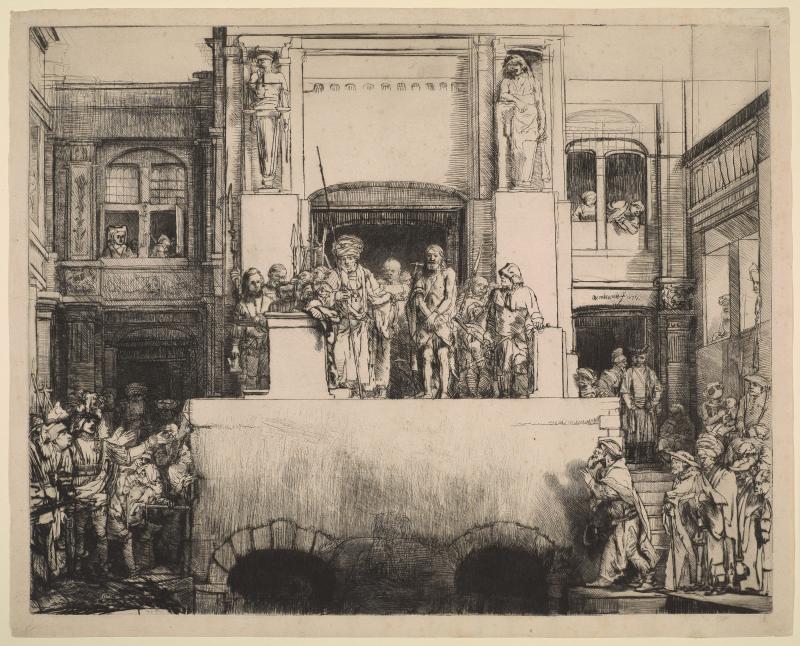
Signed and dated, "Rembrandt f 1655" on the architrave above the doorway to the right of the podium (in state VII).
Watermark: Fleur-de-lis in shield, surmounted by crown, over "4" and letters "WR", (Strasbourg lily).
Watermark: Countermark: "IHS" and cross exteding from crossbar of H" (Heawood 1780).
Matthew 27:21-23 and Mark 15:1-15.
Margins 9.5-12 mm
Rembrandt's unparalleled printmaking skills reach their zenith in this exceptional impression of Christ Presented to the People or Ecce Homo. The artist depicts an event from the Christian Bible's New Testament in which a jeering crowd demands Jesus's crucifixion. Rembrandt's exacting eye for detail regards the dazzling display of bold poses and striking facial expressions seen among the swarm of people. From the man at left with a jaunty feathered cap and curling moustache to the many onlookers with raised hands and open mouths, we can practically hear the din of the gathering horde. In contrast, the figure of Christ--dressed in rags, hands bound, a despondent stare on his face--is a solemn, silent presence in the very center of the composition. Rembrandt powerfully pictures the dramatic array of emotions that transpire as, one by one, each person in the crowd contemplates their role as judge and executioner, the fine line between power and brutality. In depicting this scene, Rembrandt allows us, too, to become onlookers and similarly contemplate our own humanity and that of our friends, strangers, heroes, and enemies.
Rembrandt was an avid collector and learned student of history, and his work often references literary and artistic precedents. Indeed, his Ecce Homo was inspired by Dutch artist Lucas van Leyden's famous print of the same subject, done in 1510. Contemporary events in Amsterdam, where Rembrandt lived, also informed his work. The statues depicted in this print, for instance, resemble those found in the city's (then) newly constructed municipal hall, which included a tribunal chamber where magistrates announced death sentences.
Ecce Homo is among the largest of prints in Rembrandt's oeuvre. This rare first state impression has distinctively dark, velvety, black lines that exemplify the artist's innovative drypoint technique. Rembrandt used a needle-like implement to incise a design onto a large copper plate that was then inked and pressed onto a sheet of Japanese paper. In order to accommodate the oversized metal plate, Rembrandt enlarged the page with a thin strip of paper, today evident in the faint brown stripe along the top edge. Bustling trade between Japan and the Netherlands ensured Rembrandt had access to the smooth and luminous paper he admired and used increasingly from the late 1640s.
Pierpont Morgan purchased this print, alongside 111 others, from George W. Vanderbilt in 1906. Their mutual interest reflects the late-nineteenth and early-twentieth century mania among wealthy art collectors in the U.S. for all things Rembrandt. Ecce Homo remains a jewel in The Morgan Library and Museum's spectacular collection of more than 500 of Rembrandt's etchings and 22 drawings. Belle da Costa Greene, the Morgan's first director, affirmed in a 1940 letter to Morgan's son, Jack, that the “collection [of Rembrandt etchings] is of great importance...by far the finest in America.” -Sarah W. Mallory
The roughening of the surface of the plate which occurred when the crowd was erased [in the sixth state] is used to characterize the wall surface. Two dark archways, possibly entrances to cells or dungeons, penetrate this wall. The dimly seen, enigmatic bearded figure adds a sense of disquiet. Set off by deeper shadow and further modeled, the figure of Christ is more readily isolated from the surrounding group. (Boston 1969, no. 68 [modified])


